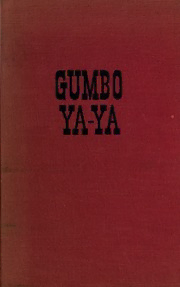
Gumbo ya-ya PDF
Preview Gumbo ya-ya
-^,?m^ ^ *> P, T From the collection ofthe m T> "r Prepnger v Jjibrary San Francisco, California 2006 YA-YA Compiled by LYLE SAXON, State Director, EDWARDDREYER,Asst.State Director, ROBERT TALLANT, Writer Special Material Gathered by Workers of the Works'Progress Administration, Louisiana Writers' Project, and Sponsored by The Louisiana State Library Commission. DrawingsbyCAROLINKDURIFUX * Jacket and Decorations by ROLAND DUVERNET Illustrated 'with Photographs I A HOUGHTON MIFFL1 COMPANY BOSTO r i&tbergibe LOUISIANA WRITERS PROJECT PUBLICATIONS New Orleans City Guide Louisiana State Guide Gumbo Ya-Ya BOOKS BY LYLE SAXON Father Mississippi Fabulous New Orleans Old Louisiana Lafitte the Pirate Children of Strangers BOOKS BY ROBERT TALLANT Voodoo in New Orleans COPYRIGHT, 1945, BY THE LOUISIANA LIBRARY COMMISSION, ESSAB M. CULVER, EXECUTIVE SECRETARY WORKS PROJECT ADMINISTRATION Howard 0. Hunter, Commissioner Mrs. Florence Kerr, AssistantCommissioner James H. Crutcher, Administratorfor Louisiana QPije JcUbrrBifir $re CAMBRIDGE MASSACHUSETTS PRINTED IN U. S. A. Preface GUMBO YA-YA 'EVERYBODY TALKS AT ONCE' IS a phrase often heard in the Bayou Country of Louisiana. ThisGumbo Ya-Yaisa bookofthelivingfolkloreofLouisiana. Assuch itisprimarily theworkofthosecharacters, real orimag- inary, living ordead, who created this folklore. We wish to ex- press our indebtedness, therefore, to Madame Slocomb, who was so polite that she invited even the dead to her parties; and to ValcourAime and the golden plates at the bottom ofthe Missis- sippi; to Monsieur Dufau and his ciel-de-lits, and to Tante Na- omie, bold in her 'bare feets' at the blessing of the shrimp fleet; to the ghost of Myrtle Grove and the loup-garous of Bayou Goula; to Mike Noud and 'The Bucket of Blood,' and toJennie Green McDonald, left alone in the original Irish Channel; to Mrs. Messina, who had everything, including half an orphan, and to Mr. Plitnick, who had the timidity; to Miss Julie, who rouged her roses, and to Mrs. Zito, who made everybody cry to beat the band to Chief Brother Tillman, for whom Mardi Gras ; was life, and to Creola Clark, 'who kept her mind on Mama'; to John Simms,'Junior, the chimney sweep on a holiday, and to all the vendors ofpralines and calastoutchauds; toEvangeline and to Lafitte the Pirate; to Annie Christmas and Marie Laveau; to Pere Antoine and Pepe Lulla; to Mamzelle Zizi andJosie Arlington and the hop head's love, 'Alberta'; to Long Nose and Perfume Peggy; to Mother Catherine and the Reverend Maude Shannon; to Coco Robichaux and Zozo la.Brique; to Crazah and Lala and BanjoAnnie; and to the BabyDoll who had beena BabyDollfor twenty years. vi Preface The material for this book was gathered by members of the Louisiana Writers' Program of the Work Projects Administra- tion. The idea was suggested by Henry G. Alsberg in 1936; he was then the National Director ofthe Federal Writers' Program. WeinLouisianawerepleasedwith theidea, and ateverypossible opportunity assigned workers to the task of collecting the folk- lore of the State. The Louisiana Library Commission, ofwhich Essae M. Culver is Executive Secretary, has sponsored this book, as well as the earlier publication, the Louisiana State Guide. The city of New Orleans sponsored our first publication, The New Orleans City Guide. It may be well to remember that Louisiana was first a French colony, then Spanish, and that the territorywas nearly a century old before becoming a part ofthe United States. It was an agri- cultural territory and many thousands of Negro slaves were im- ported. In the plantation sections the Negroes outnumbered the Whites five to one; consequently their contribution to the folk- lore of the State has been large. The Creoles, those founders ofthe French colony, contributed theirelegance, their customs, and cuisine. They influenced their slaves and, in a sense, their slaves influenced them. In Southwest Louisiana lived the Acadians or Cajuns, as they are affectionately called those sturdy farming folk who, driven from their homes in Nova Scotia at the end of the eight- eenth century, populated that area. It would seem that the whole of Louisiana was a peculiarly fecund part ofthe Americas; the forests werefilled with birds and animals, the bayous and lakes were teeming with fish, and the Creole mansions and the Cajun cottages were full of children. In a leisurely collection of the folklore of the various racial groups, we have attempted to have the collecting of material doneeitherbymembersofthegroups themselves orby thoselong familiar with such groups. For example, in the stories pertain- ing to the Creoles much of the work was done by Madame JeanneArguedas, MadameHenrietteMichinard, MonsieurPierre Lelong, Caroline Durieux, and especially by Hazel Breaux, who
